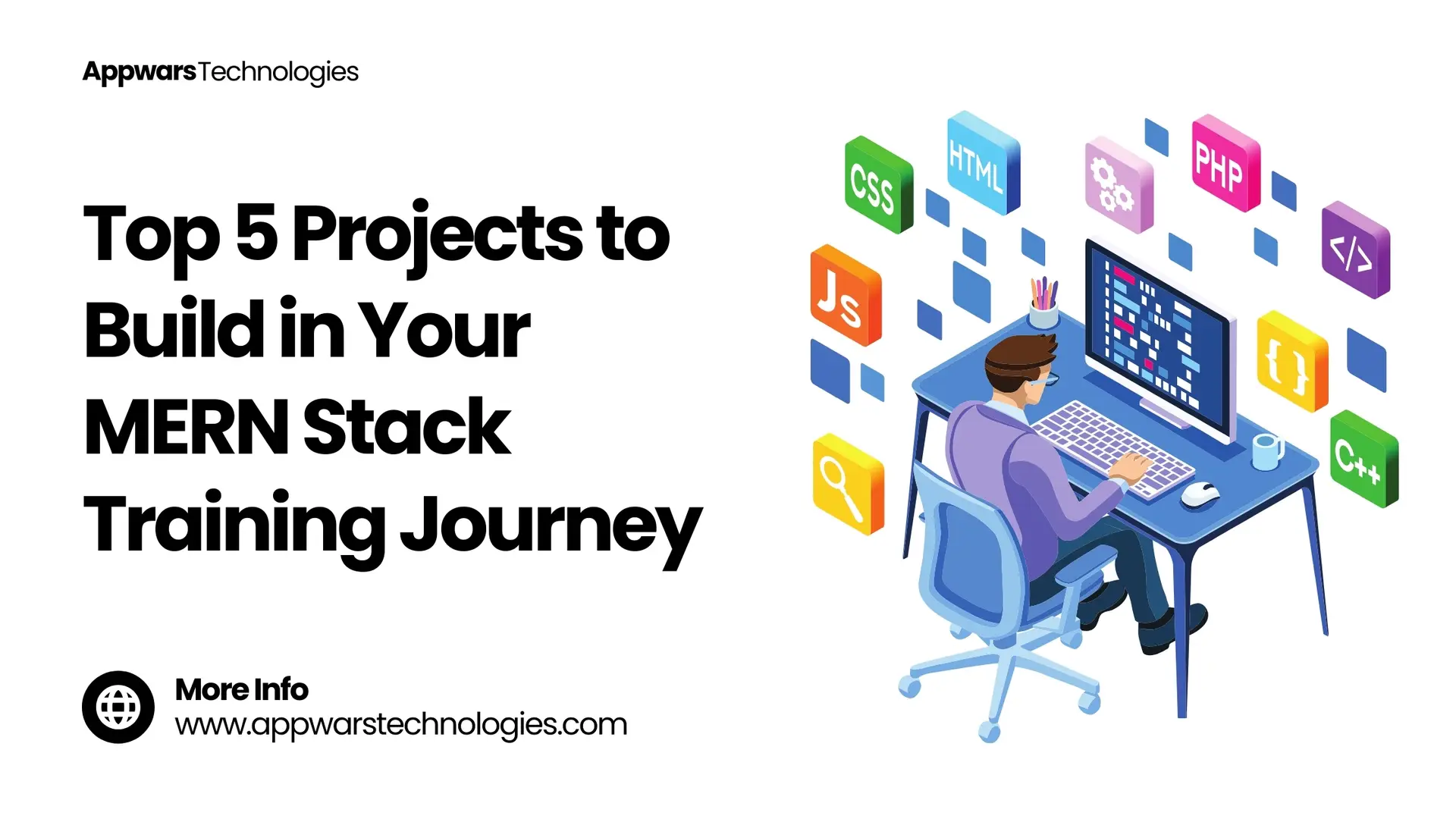Embarking on a journey in the MERN stack can open doors to countless opportunities in full-stack development. Consisting of MongoDB, Express.js, React, and Node.js, the MERN stack provides a robust framework for building dynamic and high-performance applications. Each component of this stack plays a crucial role in modern web development:
- MongoDB for data storage,
- Express.js as a server-side framework,
- React for crafting seamless, interactive frontends, and
- Node.js as the runtime environment.
While theory provides a strong foundation, hands-on practice is crucial for truly understanding how the components work together. Here are five top project ideas to enhance your MERN stack training and provide you with practical experience to showcase in your portfolio.
1. E-commerce Platform
An e-commerce platform is one of the best ways to understand the complexities of a full-stack application, making it ideal for testing and sharpening MERN stack skills.
Key Features to Include:
- User Authentication and Authorization: Implement registration and login using JWT (JSON Web Tokens) to ensure secure access.
- Product Listings: Design a dynamic product catalog using MongoDB as your database, enabling CRUD operations.
- Shopping Cart and Checkout: Build a shopping cart feature using React’s state management and enable secure payments through integration with payment gateways like PayPal or Stripe.
- Admin Dashboard: Develop a backend dashboard for admin users to manage product listings, view sales, and update inventory.
- Order Tracking: Let users track their orders, providing a complete end-to-end experience.
Technical Learning Points:
- React for UI/UX: Use React to design product cards, filters, and search options that make the site interactive.
- Backend with Express and Node.js: Create RESTful APIs for product data, authentication, and order processing.
- Database Management: Use MongoDB to handle a large volume of product and user data efficiently, learning data modeling and schema design.
- Integrations: Integrate third-party payment APIs, providing experience with external API services.
Why This Project is Valuable:
Building an e-commerce platform will provide a well-rounded experience in frontend and backend development, API integration, and user experience design. You’ll gain skills in handling real-time data, security measures, and optimization strategies, making it a standout project on your resume.
2. Social Media Application
Developing a social media application allows you to create a highly interactive platform, offering insights into user engagement features and the challenges of building large-scale, real-time applications.
Key Features to Include:
- User Authentication and Profile Creation: Enable users to sign up, create profiles, upload photos, and add personal information.
- News Feed and Posting: Build a news feed using MongoDB and Express.js to store and retrieve posts, with React rendering content dynamically.
- Following/Unfollowing Mechanism: Implement a feature that allows users to follow/unfollow others, providing a social graph feature.
- Real-time Notifications: Integrate real-time notifications for likes, comments, or follows using WebSockets or a similar technology.
- Messaging System: Create a messaging system where users can interact directly, perhaps incorporating a real-time chat feature.
Technical Learning Points:
- Data Relationships: Learn how to model relationships between users, posts, and comments in MongoDB.
- Real-time Functionality: Explore WebSockets with Node.js to create real-time interactions.
- Complex UI with React: Use React components and Redux to manage state effectively, especially for data-intensive features like the news feed.
- Backend API Development: Understand how to create secure, scalable APIs to manage user data, posts, comments, and messages.
Why This Project is Valuable:
Building a social media app offers an introduction to real-time data and scalability, two crucial aspects of web development. It’s an impressive portfolio addition because it combines skills in data modeling, UI development, real-time functionalities, and complex state management.
3. Real-time Chat Application
A real-time chat application is an essential project for understanding WebSockets and real-time data updates. This project will introduce you to the fundamentals of live communication, providing a real-world skill that is highly valuable in web development.
Key Features to Include:
- User Authentication: Allow users to register and log in.
- One-on-One Chat: Enable users to chat with each other in real-time.
- Group Chat: Expand the chat functionality by allowing group conversations.
- Message Read Receipts: Implement read receipts so users know when their messages have been viewed.
- Typing Indicator: Add a feature that shows when the other user is typing.
Technical Learning Points:
- WebSocket Integration: Use WebSockets or Socket.IO with Node.js to enable real-time messaging.
- Frontend and Backend Synchronization: Learn how to synchronize user activity on both ends with low latency.
- Optimized Data Handling: Use MongoDB to efficiently store and retrieve messages.
- React for Interactive UI: Build an interactive chat interface using React components for real-time data updates.
Why This Project is Valuable:
Real-time chat applications demonstrate an understanding of asynchronous, real-time updates, which are highly sought-after in web applications today. This project also highlights your ability to work with real-time technologies, optimize data handling, and deliver seamless, real-time interactions.
4. Project Management Tool
Creating a project management tool can help you gain insights into organizing tasks, tracking progress, and managing teams, making it a practical project with real-world applications.
Key Features to Include:
- User Authentication and Roles: Implement a system where users can have different roles like admin, manager, and team member.
- Task Management: Allow users to create, assign, and update tasks with due dates and statuses.
- Progress Tracking: Enable visual progress tracking through graphs, charts, or Kanban boards.
- Notifications: Set up notifications for task updates, due dates, and team messages.
- File Sharing: Provide an option for team members to upload and share files for specific tasks.
Technical Learning Points:
- Role-based Authentication: Use Node.js and Express to implement role-based access control.
- React Components: Use React for building interactive boards and real-time updates on task progress.
- Data Aggregation in MongoDB: Learn how to manage and aggregate task data effectively for efficient querying.
- Real-time Notifications: Implement WebSocket or push notifications for task updates.
Why This Project is Valuable:
This project is a great showcase of organizational and management-oriented functionalities, demonstrating how you can build applications that are crucial for productivity. With a project management tool in your portfolio, potential employers can see your skills in creating structured, user-friendly interfaces and data management systems.
5. Blog Application with CMS Functionality
A blog platform with CMS (Content Management System) capabilities is an excellent project for understanding how to structure a content-heavy website, with added functionality for content management, which many businesses need.
Key Features to Include:
- User Roles: Differentiate between authors, editors, and readers with role-specific permissions.
- Content Editor: Design a CMS dashboard where authors can write, edit, and publish posts.
- Tagging and Categorization: Allow users to organize posts by tags and categories.
- Commenting System: Build a comment section to encourage reader interaction.
- Search and Filter Functionality: Enable readers to search for content or filter by tags or categories.
Technical Learning Points:
- Role Management: Set up role-based permissions for authors and editors.
- React for Dynamic UI: Use React for the frontend, focusing on designing a responsive, user-friendly CMS interface.
- Database Structure: Create a database schema that efficiently stores and organizes posts, tags, comments, and user data in MongoDB.
- Backend with REST APIs: Build robust backend APIs to manage posts, categories, comments, and user roles.
Why This Project is Valuable:
This project highlights your ability to create structured content management systems, a common requirement for business and marketing websites. Through this, you’ll gain experience with CRUD operations, UI/UX design for administrative tasks, and data management for large-scale content storage.
Final Thoughts
Building these projects will prepare you to tackle a variety of real-world web applications. They require a solid understanding of each component of the MERN stack and will provide ample opportunity to practice both frontend and backend development. Completing these projects not only builds technical skills but also provides you with impressive portfolio pieces to showcase your expertise to potential employers.
At Appwars Technologies, we understand the importance of project-based learning. Our MERN stack training program is designed to equip students with hands-on experience through real-world projects like these, ensuring a smooth transition into the industry. Whether you’re a beginner or looking to deepen your existing skills, these projects can provide you with the practical knowledge and confidence to excel as a MERN stack developer.







